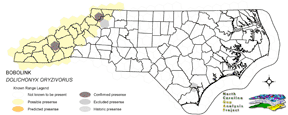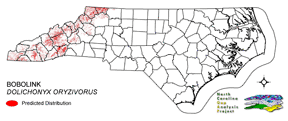
| Taxa: |
| Order: |
| Family: |
| Aves |
| Passeriformes |
| Icteridae |
| NatureServe Global Rank: |
| NatureServe State (NC) Rank: |
| G5 |
| SAB,SZN |
| Federal Status: |
| NC State Status: |
| --- |
| --- |


| Land Unit |
| US Fish & Wildlife Service |
| US Forest Service |
| US National Park Service |
| US Department of Defense |
| NC State Parks |
| NC University System |
| NC Wildlife Res. Com. |
| NC Forest Service |
| NC Div. of Coastal Mgmt. |
| Local Governments |
| Non-Governmental Org. |
| Other Public Lands |
| Private Lands |
| GAP Status 1-2 |
| All Protected Lands |
| Statewide |
| Hectares |
| 0.00 |
| 11,440.98 |
| 11.88 |
| 3,245.40 |
| 414.18 |
| 2.97 |
| 284.58 |
| 216.00 |
| 0.00 |
| 67.23 |
| 208.44 |
| 116.28 |
| 312,924.15 |
| 4,542.30 |
| 15,864.84 |
| 328,932.09 |
| Acres |
| 0.00 |
| 28,271.27 |
| 29.36 |
| 8,019.56 |
| 1,023.46 |
| 7.34 |
| 703.21 |
| 807.29 |
| 0.00 |
| 166.13 |
| 515.07 |
| 287.33 |
| 773,252.26 |
| 11,497.81 |
| 39,476.41 |
| 813,082.28 |
| % of Dist. on |
| Prot. Lands |
| 0.0 % |
| 72.1 % |
| 0.0 % |
| 20.5 % |
| 2.6 % |
| < 0.1 % |
| 1.8 % |
| 1.4 % |
| 0.0 % |
| 1.2 % |
| 1.2 % |
| < 0.1 % |
| 0.0 % |
| 28.6 % |
| ----- |
| ----- |
| % of Dist. on |
| All Lands |
| 0.0 % |
| 3.5 % |
| < 0.1 % |
| 1.0 % |
| 0.1 % |
| < 0.1 % |
| < 0.1 % |
| < 0.1 % |
| 0.0 % |
| < 0.1 % |
| < 0.1 % |
| < 0.1 % |
| 95.1 % |
| 1.4 % |
| ----- |
| ----- |
|
May rarely nest in the extreme northwestern part of the state. One nesting record exists from North Wilkesboro, along with numerous summer sitings of individuals (Potter et al. 1980). Prefers mesic weedy meadows and hayfields; avoids dry fields (Jaramillo and Burke 1999) and marshes (Skutch 1996). Nests in a depression on the ground among tall grasses. Sings from elevated perches such as weeds, telephone wires, or treetops. Forages on the ground for insects and seeds (Skutch 1996) NATURE SERVE GLOBAL HABITAT COMMENTS: Tall grass areas, flooded meadows, prairie, deep cultivated grains, hayfields. In migration and winter also in rice fields, marshes, and open woody areas (AOU 1983). In New York, old hayfields, at least 8 years since planting and including a minimum of alfalfa, were important nesting habitat (Bollinger and Gavin 1992). Nests on ground in small hollow in area of concealing herbaceous vegetation. Tends to return to breed in same area in successive years, especially if that site has had good bobolink productivity (Bollinger and Gavin 1989). |
| Code | Name | Description | NC Natural Heritage Program Equivalent |
| 180 | Agricultural Crop Fields | Farm fields used for row crops. | No equivalent |
| 205 | Agricultural Pasture/Hay and Natural Herbaceous | Farm fields used for pasture grass or hay production, as well as old fields dominated by native and exotic grasses. | No equivalent |
| 523 | Grassy Bald | High Elevation grassy balds including Pennsylvania sedge, mountain oatgrass, as well as shrubby areas dominated by Alleghany and smooth blackberry. | Grassy Bald |
|
Carter, M., G. Fenwick, C. Hunter, D. Pashley, D. Petit, J. Price, and J. Trapp. 1996. Watchlist 1996:For the future. Field Notes 50(3):238-240.
Hagan, J.M., III, and D.W. Johnston, editors. 1992. Ecology and conservation of neotropical migrant landbirds. Smithsonian Institution Press, Washington, D.C. xiii + 609 pp. Sauer, J.R., and S. Droege. 1992. Geographical patterns in population trends of neotropical migrants in North America. Pages 26-42 in J.M. Hagan III and D.W. Johnston, editors. Ecology and conservation of neotropical migrant landbirds. Smithsonian Institu Bollinger, E. K., and T. A. Gavin. 1989. The effects of site quality on breeding-site fidelity in bobolinks. Auk 106:584-594. Bollinger, E. K., P. B. Bollinger, and T. A. Gavin. 1990. Effects of hay-cropping on eastern populations of the bobolink. Wildl. Soc. Bull. 18:142-150. Bent, A.C. 1958. Life histories of North American blackbirds, orioles, tanagers, and their allies. U.S. National Museum Bulletin 211. Washington, DC. Johnson, R.G., and S.A. Temple. 1990. Nest predation and brood parasitism of tallgrass prairie birds. Journal of Wildlife Management 54:106-111. Gavin, T. A. 1984. Broodedness in bobolinks. Auk 101:179-181. Harrison, C. 1978. A field guide to the nests, eggs and nestlings of North American birds. Collins, Cleveland, Ohio. Potter, E. F., J. F. Parnell, and R. P. Teulings. 1980. Birds of the Carolinas. Univ. North Carolina Press, Chapel Hill. 408 pp. Terres, J.K. 1980. The Audubon Society encyclopedia of North American birds. Alfred A. Knopf, New York. American Ornithologists' Union (AOU), Committee on Classification and Nomenclature. 1983. Check-list of North American Birds. Sixth Edition. American Ornithologists' Union, Allen Press, Inc., Lawrence, Kansas. National Geographic Society (NGS). 1983. Field guide to the birds of North America. National Geographic Society, Washington, D.C. Raffaele, H.A. 1983. A guide to the birds of Puerto Rico and the Virgin Islands. Fondo Educativo Interamericano, San Juan, Puerto Rico. 255 pp. Hilty, S.L., and W.L. Brown. 1986. A guide to the birds of Colombia. Princeton University Press, Princeton, New Jersey. 836 pp. Ridgely, R. S., and J. A. Gwynne, Jr. 1989. A guide to the birds of Panama with Costa Rica, Nicaragua, and Honduras. Second edition. Princeton Univ. Press, Princeton, New Jersey. 534 pp. Ridgely, R.S., and G. Tudor. 1989. The birds of South America. Vol. 1. The Oscine passerines. Univ. Texas Press, Austin. 516 pp. Stiles, F.G., and A.F. Skutch. 1989. A guide to the birds of Costa Rica. Comstock Publ. Associates, Cornell University Press, Ithaca, New York. 511 pp. Bollinger, E. K., T. A. Gavin, and D. C. McIntyre. 1988. Comparison of transects and circular-plots for estimating bobolink densities. J. Wildl. Manage. 52:777-786. Bollinger, E. K., and T. A. Gavin. 1992. Eastern bobolink populations:ecology and conservation in an agricultural landscape. Pages 497-506 in B92HAG01NAUS. |
For more information please contact them at:
NC-GAP Analysis Project
Dept. of Zoology, NCSU
Campus Box 7617
Raleigh, NC 27695-7617
(919) 513-2853
www.basic.ncsu.edu/ncgap